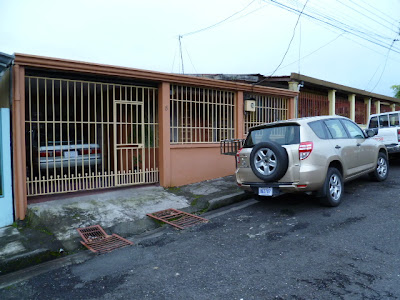The factory workers were packing it in for the day but my faithful guide, Guilermo, met me at the gate and conducted a private tour for me. I had my choice of English or Spanish and I chose Spanish. We started with the plants (above), where I picked a red berry, bit the top off and squeezed the two seeds (coffee beans) into my mouth--per instructions. They tasted sweet.
Then Guilermo gave me a good explanation of how the plants get started. We progressed to the factory where he showed me the bin where coffee pickers empty berries from their waist baskets. I'm pretty sure that he told me the daily wage for a coffee picker is around $2 a day. And if you bring too many green berries to the factory you're toast. Here's Guilermo demonstrating a small extractor that removes the beans from the berries.
We moved into the factory proper and he explained all the steps from washing, grading, roasting all the way to packaging. Here's where the beans move after washing.
I won't get into all the details--there's a lot of work that goes into processing coffee beans before they find their way to Starbucks. One of the final steps is a place where two women grade the roasted beans by taste. The factory uses machinery made mostly in Costa Rica. At the tasting stage the women use this machine from Germany to produce any type of coffee, from regular to high test espresso.
The coffee then goes into individual bags that are bundled up and shipped out once a week to hotels and restaurants. Golden Bean coffee is not sold in stores here. When a buyer comes to the factory he or she makes a selection based on the "sip 'n' spit' technique of tasting, invented by Folgers in the early 1900s. I did a bit of sipping and spitting--I was able to pick the highest grade by tasting. Here's the taste test location.
Every tour ends in the store where you have the opportunity to buy as much coffee as you're willing to carry or ship home.
The coffee tour was a great deal, only $12. If you go with a group in a bus it's $60. I enjoyed it--it was a fitting end to this chapter of tourism in Costa Rica. I heard more than once during my visit that until coffee came to Costa Rica the country really didn't have much going for it--everyone was poor. Add coffee, bananas and tourism and you have a very rich country compared to others in Central America.
Pura vida!
























